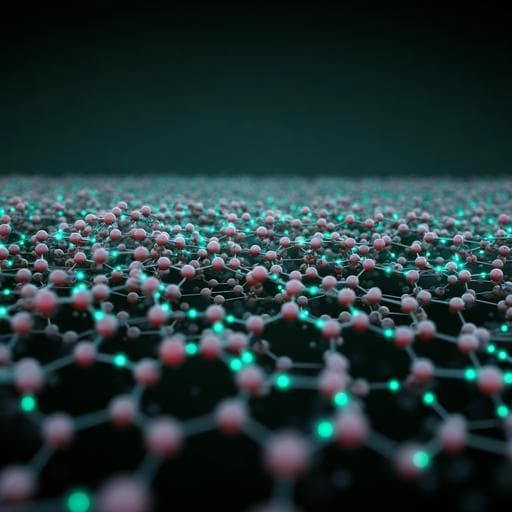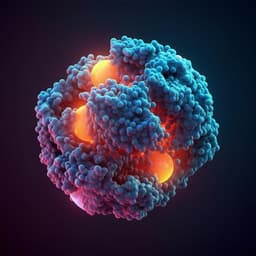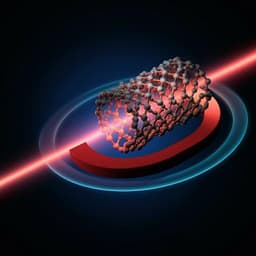
Physics
Spin defects in hBN as promising temperature, pressure and magnetic field quantum sensors
A. Gottscholl, M. Diez, et al.
This groundbreaking research by authors including Andreas Gottscholl and Matthias Diez reveals how negatively charged boron vacancies in hexagonal boron nitride can serve as atomic-scale sensors for measuring temperature, magnetic fields, and pressure. The findings highlight the impressive sensitivity of these intrinsic sensors in 2D material heterostructures.
~3 min • Beginner • English
Introduction
Spin defects in wide band-gap semiconductors enable optically detected magnetic resonance (ODMR) for initializing, manipulating, and optically reading out spin states, thereby allowing external stimuli (magnetic/electric fields, temperature, pressure) to be mapped onto spin transitions. Leading systems include NV centers in diamond and spin defects in SiC (divacancies and silicon vacancies), which have delivered nanoscale sensing in physics and biology. However, in 3D hosts it is challenging to place spin defects close to the surface without degrading spin coherence, limiting sensitivity and minimum sensor-to-object standoff. Layered materials offer an alternative. Hexagonal boron nitride (hBN), a stackable 2D material, hosts a variety of color centers including spin-active defects. The negatively charged boron vacancy (V_B^−) in hBN has an S = 1 ground state with ZFS D/h ≈ 3.5 GHz and bright PL near 850 nm; it can be created by neutron irradiation, ion implantation, or femtosecond laser writing. This work investigates how external stimuli affect V_B^− spin levels and demonstrates its capabilities as a nanoscale sensor for temperature, pressure, and magnetic fields, leveraging the sensitivity of its zero-field splitting to lattice parameter changes and its g-factor-based Zeeman response.
Literature Review
Prior work established ODMR-based sensing with NV centers in diamond and defects in SiC, achieving high sensitivity for magnetic fields and thermometry, including biological applications. Limitations arise in 3D materials due to surface proximity affecting coherence. Theoretical and experimental studies identified spin defects in hBN, with V_B^− becoming the best-understood, including its creation pathways and room-temperature coherent control. Temperature and pressure dependences of ZFS in NV centers have been examined, providing a framework for relating lattice parameter changes to ZFS shifts. Elastic properties and anisotropic thermal expansion of hBN have been reported, indicating opposite temperature trends for in-plane (a) and out-of-plane (c) lattice parameters, which can be exploited for sensing. Comparative studies of sensitivities across diamond, SiC, and hBN inform benchmarking of coupling coefficients and resolutions.
Methodology
Samples: Single-crystal hBN composed of thousands of layers; V_B^− centers generated by neutron irradiation (~2.3 × 10^18 n cm^−2). Defect density determined by dark EPR as ~5.4 × 10^17 cm^−3 (~10^13 spins total). Crystal lattice parameters: interlayer spacing c = 6.6 Å; in-plane lattice constant a = 2.5 Å.
Temperature-dependent ODMR: Continuous-wave ODMR measured between ~5 and 350 K with and without static magnetic field B. Room-temperature zero-field ODMR shows two resonances ν1, ν2 centered around ν0 with D/h = 3.48 GHz and off-axis ZFS E/h ≈ 50 MHz. Under B, resonances follow ν_{1,2} = D_0/h ± (1/h)√(E^2 + (gμ_B B)^2). Hyperfine structure from three equivalent 14N (I = 1) neighbors yields seven subpeaks.
Temperature-to-ZFS model: The temperature dependence of D is modeled via lattice parameter changes a(T), c(T) (from Paszkowicz et al.), adopting linear proportionality between D and relative lattice changes η_a(T), η_c(T): D(T) = D(295 K) + θ_a η_a(T) + θ_c η_c(T). Fits to experimental D(T) under B = 0 and 8.5 mT extract θ_a and θ_c. A piecewise polynomial D(T) is provided for direct thermometry across specified temperature intervals, using η_a,c computed from a(T), c(T).
Pressure sensing: First-order isothermal, no shear strain model using hBN elastic constants (C_11 = 811 ± 12 GPa, C_12 = 169 ± 24 GPa, C_13 = 0 ± 3 GPa, C_33 = 27 ± 5 GPa) relates applied stress along crystallographic axes to η_a,c and thus to D shifts. Experimentally, normal pressure along c was applied by stacking calibrated weights on the sample. To enhance SNR, sinusoidal modulation of the static B-field was used, producing first-derivative ODMR lineshapes. Linear fits near zero-crossings of ν1, ν2 provided precise frequency shifts versus pressure, yielding d(D/h)/dσ.
Magnetic field sensing: ODMR used for B ≤ 20 mT; to extend field range, multifrequency EPR: cw X-band EPR at 9.4 GHz and ESE-detected W-band EPR at 94 GHz up to 3.5 T, enabling precise g-factor extraction. Simulations of ν1,2(B) at different temperatures compare with ODMR/EPR data. Shot-noise-limited magnetic sensitivity estimated using δB ≈ 1/(gμ_B)·1/(√(R η N t)·T2*), with parameters taken from measurements (R ≈ 0.1%, η ≈ 1%, N ≈ 2.6×10^9 spins in ~10 μm voxel, T2* ≈ 100 ns, t = 1 s).
ODMR setup (Methods): 532 nm laser excitation (Cobolt Samba 100) through 10× objective (NA = 0.3) focusing ~10 μm spot; PL collected via dichroic and 532 nm long-pass filter into 600 μm fiber to APD (Thorlabs APD440A). Microwaves from SG384 generator amplified (Mini-Circuits ZVE-3W-83+) applied via 0.5 mm copper strip-line. Lock-in detection with microwave on/off, or sinusoidal B-field modulation; external field from a permanent magnet for low-field ODMR.
Key Findings
- The V_B^− center in hBN exhibits D/h = 3.48 GHz and E/h ≈ 50 MHz at room temperature; PL emission around 850 nm; S = 1 ground state with ODMR-resolvable hyperfine structure from three 14N neighbors.
- Temperature sensing: D shifts by ΔD ≈ 195 MHz from 295 K to 10 K, far exceeding NV in diamond (~7 MHz over similar range). The D(T) dependence is well described by lattice thermal expansion/contraction: D(T) = D(295 K) + θ_a η_a(T) + θ_c η_c(T), with θ_c = (−81 ± 12) GHz and θ_a = (−24.5 ± 0.8) GHz. Maximum fit error < 5 MHz, within data scatter. A piecewise polynomial for D(T) is provided for 5–350 K with coefficients listed (three temperature regions).
- Pressure sensing: For out-of-plane (c-axis) pressure, measured slope d(D/h)/dσ_z = (1.16 ± 0.15) Hz/Pa, close to the calculated (0.91 ± 0.20) Hz/Pa based on elastic constants. Demonstrated precision improved by B-field sinusoidal modulation yielding first-derivative ODMR and ~4× higher SNR.
- Magnetic field sensing: ν1,2(B) follow the expected Zeeman behavior; linear regime for B ≳ 3 mT due to finite E. Multifrequency EPR yields g = 2.0046 ± 0.0021. ODMR-based magnetic field resolution estimated as ~85.1 μT/√Hz at 295 K and 4.33 μT/√Hz at 50 K; shot-noise-limited δB ≈ 20 nT/√Hz is achievable with realistic parameters.
- Comparative sensitivities (50–350 K linear regime): Temperature coupling Γ_T = d(D/h)/dT ≈ −623 kHz/K, >8× larger than NV centers in diamond (−74 kHz/K). At cryogenic T ≤ 10 K, hBN retains significant dD/dT ≈ −87 kHz/K, whereas NV in diamond is ~−0.07 kHz/K. Reported general temperature resolution δ ≈ 3.82 K/√Hz at 295 K and 0.19 K/√Hz at 50 K under cw ODMR; pressure resolutions (room temperature) on the order of 10^6 Pa/√Hz depending on stress direction (e.g., σ_z ~2.62×10^6 Pa/√Hz), improving at 50 K.
Discussion
The findings demonstrate that V_B^− centers in hBN function as versatile nanoscale sensors for temperature, pressure, and magnetic fields. The mechanism for temperature and pressure sensing is the strong, linear coupling of the ground-state ZFS to lattice parameter changes, enabled by hBN’s anisotropic thermal expansion and compliant out-of-plane elasticity. The extracted coupling coefficients (θ_c, θ_a) quantitatively link D to lattice deformations, validating a simple model that uses crystallographic data. Magnetic field sensing relies on the g-factor and is independent of lattice variations, permitting simultaneous B-field sensing alongside temperature or pressure measurements, provided isothermal or isobaric conditions are maintained to decouple cross-sensitivities.
Compared to 3D hosts, the 2D nature of hBN allows placement of sensors within sub-nanometer distances (~0.33 nm with three-layer stacks), minimizing standoff from target materials and potentially enhancing spatial resolution. V_B^− retains sizable temperature sensitivity down to a few kelvin, outperforming NV centers in diamond in cryogenic thermometry range. Although the cw ODMR-based sensitivities are currently below state-of-the-art NV ensemble protocols in diamond (which benefit from higher PL, contrast, and pulsed techniques), improvements in collection efficiency, ODMR contrast, and pulse protocols could narrow this gap. The combination of favorable optical extraction in 2D materials and compatibility with van der Waals heterostructures positions V_B^− as an attractive intrinsic sensor within functional 2D stacks.
Conclusion
This work establishes negatively charged boron vacancies in hBN as promising quantum sensors. The ZFS shows a large, predictable shift with temperature and applied pressure, enabling thermometry and barometry with simple cw ODMR readout. Magnetic field sensing is validated over a wide range, with precise g-factor determination. Quantitatively, the temperature coupling exceeds that of NV centers in diamond by over eightfold in 50–350 K, and significant cryogenic sensitivity is maintained. Pressure coupling along the c-axis is measured at ~1 Hz/Pa, consistent with elastic modeling. Magnetic field resolution is already comparable to SiC defects and can be further improved.
Future work should focus on enhancing photon collection (higher NA optics, nanophotonics), increasing ODMR contrast, implementing advanced pulsed sensing protocols to exploit longer coherence times, and exploring ultrathin (few-layer to monolayer) configurations within heterostructures, including calibration for substrate-induced modifications of D and coupling parameters.
Limitations
- Cross-sensitivity: Temperature and pressure both shift D; accurate sensing requires isothermal (for pressure) or isobaric (for temperature) conditions or independent calibration to decouple effects.
- Current sensitivity limits: cw ODMR with low NA collection (η ~1%) and modest ODMR contrast (~0.1%) limits performance compared to optimized NV ensemble sensors; inhomogeneous linewidth broadening impacts resolution.
- Geometry dependence: In monolayers or few-layer stacks, interactions with adjacent materials may modify D(295 K), θ_a, and θ_c, necessitating application-specific calibration.
- Experimental uncertainties: Pressure application via weights introduces area determination uncertainties; ODMR spectral overmodulation blurs hyperfine structure though aids fitting.
- Heating: Laser and microwave power can induce local heating; while characterized, it must be controlled for accurate thermometry.
Related Publications
Explore these studies to deepen your understanding of the subject.







